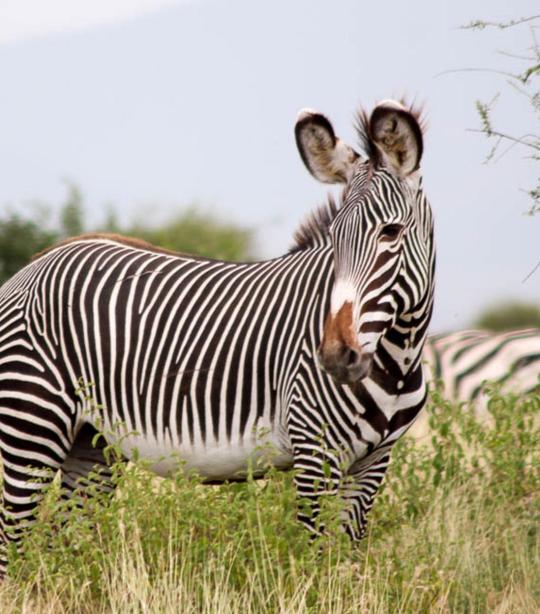Souvenir Sheet: Zebra (Equus sp.) (Ras al Khaimah 1972)
Zebra (Equus sp.) (Ras al Khaimah 1972)
01 January (Ras al Khaimah ) within release African animals goes into circulation Souvenir Sheet Zebra (Equus sp.) face value 1.65 Qatari riyal
| Souvenir Sheet Zebra (Equus sp.) in catalogues | |
|---|---|
| Michel: | Mi: RK 626EBII |
| Colnect codes: | Col: RK 1972.00.00-046c |
Souvenir Sheet is square format.
Light gray blue frame with RAS AL KHAIMA in english and arabic (variant not mentioned by Michel)Also in the issue African animals:
- Souvenir Sheet - Monkeys face value 5;
- Stamp - Giraffe (Giraffa camelopardalis) face value 80;
- Stamp - Zebra (Equus sp.) face value 1.65;
- Souvenir Sheet - Elephants face value 1.30;
- Souvenir Sheet - Giraffe (Giraffa camelopardalis) face value 80;
- Souvenir Sheet - Giraffe (Giraffa camelopardalis) face value 80;
- Souvenir Sheet - Impala (Aepyceros melampus) face value 10;
- Souvenir Sheet - Impala (Aepyceros melampus) face value 10;
- Souvenir Sheet - Lion (Panthera leo) face value 40;
- Souvenir Sheet - Lion (Panthera leo) face value 40;
- Souvenir Sheet - African Elephant (Loxodonta africana) face value 1.30;
- Souvenir Sheet - Cheetah (Acinonyx jubatus) face value 1.15;
- Souvenir Sheet - Cheetah (Acinonyx jubatus) face value 1.15;
- Stamp - Monkeys face value 5;
- Souvenir Sheet - Zebra (Equus sp.) face value 1.65;
- Souvenir Sheet - Zebra (Equus sp.) face value 1.65;
Souvenir Sheet Zebra (Equus sp.) it reflects the thematic directions:
Animals are multicellular, eukaryotic organisms of the kingdom Animalia (also called Metazoa). All animals are motile, meaning they can move spontaneously and independently, at some point in their lives. Their body plan eventually becomes fixed as they develop, although some undergo a process of metamorphosis later on in their lives. All animals are heterotrophs: they must ingest other organisms or their products for sustenance.
Mammals are any vertebrates within the class Mammalia (/məˈmeɪli.ə/ from Latin mamma "breast"), a clade of endothermic amniotes distinguished from reptiles (including birds) by the possession of a neocortex (a region of the brain), hair, three middle ear bones and mammary glands. All female mammals nurse their young with milk, secreted from the mammary glands. Mammals include the largest animals on the planet, the great whales. The basic body type is a terrestrial quadruped, but some mammals are adapted for life at sea, in the air, in trees, underground or on two legs. The largest group of mammals, the placentals, have a placenta, which enables the feeding of the fetus during gestation. Mammals range in size from the 30–40 mm (1.2–1.6 in) bumblebee bat to the 30-meter (98 ft) blue whale. With the exception of the five species of monotreme (egg-laying mammals), all modern mammals give birth to live young. Most mammals, including the six most species-rich orders, belong to the placental group. The largest orders are the rodents, bats and Soricomorpha (shrews and allies). The next three biggest orders, depending on the biological classification scheme used, are the Primates (apes and monkeys), the Cetartiodactyla (whales and even-toed ungulates), and the Carnivora (cats, dogs, seals, and allies).
Zebras (US: /ˈziːbrəz/, UK: /ˈzɛbrəz, ˈziː-/) (subgenus Hippotigris) are African equines with distinctive black-and-white striped coats. There are three living species: Grévy's zebra (Equus grevyi), the plains zebra (E. quagga), and the mountain zebra (E. zebra). Zebras share the genus Equus with horses and asses, the three groups being the only living members of the family Equidae. Zebra stripes come in different patterns, unique to each individual. Several theories have been proposed for the function of these patterns, with most evidence supporting them as a deterrent for biting flies. Zebras inhabit eastern and southern Africa and can be found in a variety of habitats such as savannahs, grasslands, woodlands, shrublands, and mountainous areas


